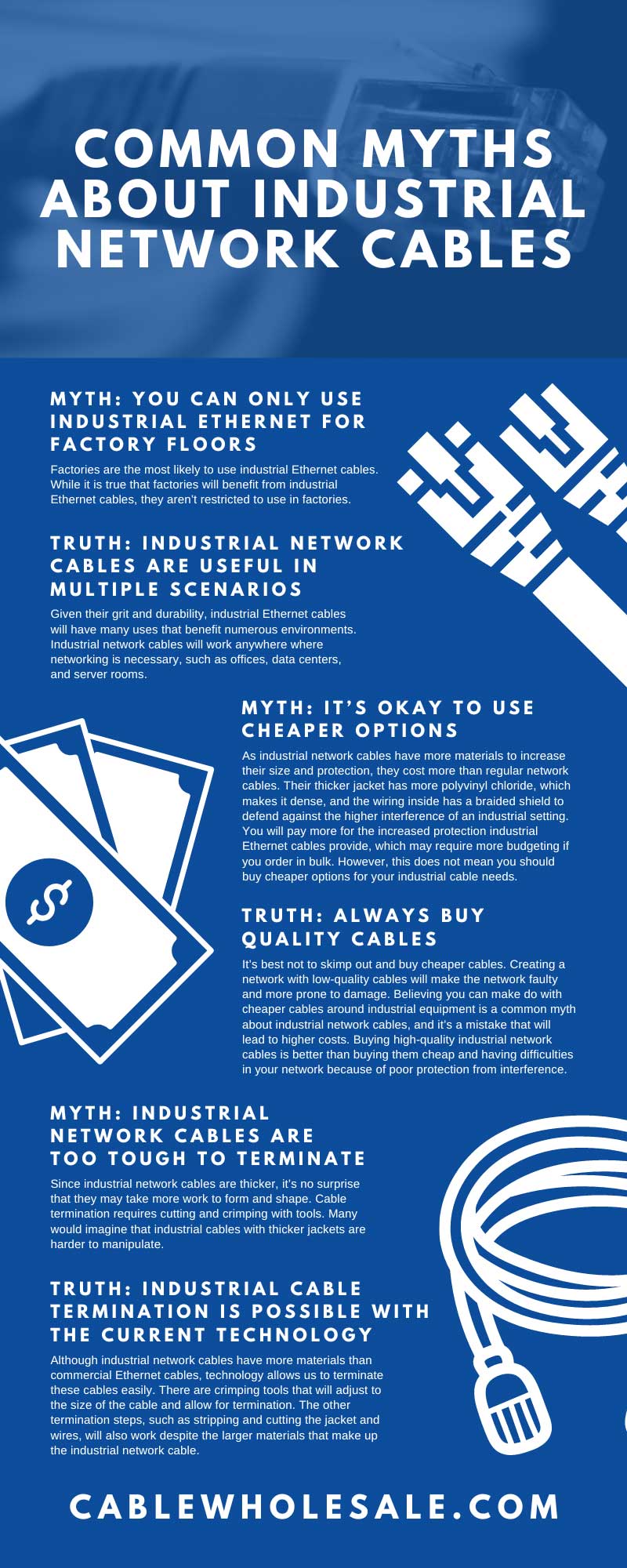
Every industry has certain beliefs surrounding it. These myths tend to derive from speculations that aren’t completely true. There are numerous myths about industrial network cables and their price, effectiveness, and components. We’ll clear the air so you can feel more comfortable using industrial network cables.
Myth: Ethernet and Industrial Ethernet Are Similar
There are various similarities between Ethernet and industrial Ethernet cables. Both transfer data in a network, and both may have built-in technology that allows them to connect devices with mitigated interference. Ethernet and industrial Ethernet cables have protective jackets that defend against various types of damage and have similar traits in their specifications, such as their transfer speed and bandwidth. However, some primary differences make them unique from each other.
Truth: Industrial Ethernet Cables Are More Heavy-Duty
While commercial Ethernet cables that we see in hardware or computer stores have cable jackets and features that grant them protection and functionality, industrial varieties have tougher aspects. Industrial Ethernet cables are designed to handle industrial equipment, as implied in the name, and have the defenses needed to withstand an industrial setting.
Industrial Ethernet cables have better heat resistance and protection from interference and vibrations, which are common occurrences in industrialized environments. An industrial cable will have a thicker jacket to protect it from environmental hazards from the surrounding machines that could jeopardize the connection.
Myth: You Can Only Use Industrial Ethernet for Factory Floors
Factories are the most likely to use industrial Ethernet cables. While it is true that factories will benefit from industrial Ethernet cables, they aren’t restricted to use in factories.
Truth: Industrial Network Cables Are Useful in Multiple Scenarios
Given their grit and durability, industrial Ethernet cables will have many uses that benefit numerous environments. Industrial network cables will work anywhere where networking is necessary, such as offices, data centers, and server rooms.
The primary difference in industrial Ethernet is their resilience against environmental hazards, but they function the same in a simple home office setting. The increased durability will benefit places such as data centers and server rooms since they are well-known for being very warm.
Myth: It’s Okay to Use Cheaper Options
As industrial network cables have more materials to increase their size and protection, they cost more than regular network cables. Their thicker jacket has more polyvinyl chloride, which makes it dense, and the wiring inside has a braided shield to defend against the higher interference of an industrial setting. You will pay more for the increased protection industrial Ethernet cables provide, which may require more budgeting if you order in bulk. However, this does not mean you should buy cheaper options for your industrial cable needs.
Truth: Always Buy Quality Cables
It’s best not to skimp out and buy cheaper cables. Creating a network with low-quality cables will make the network faulty and more prone to damage. Believing you can make do with cheaper cables around industrial equipment is a common myth about industrial network cables, and it’s a mistake that will lead to higher costs. Buying high-quality industrial network cables is better than buying them cheap and having difficulties in your network because of poor protection from interference.
Myth: Industrial Network Cables Are Too Tough To Terminate
Since industrial network cables are thicker, it’s no surprise that they may take more work to form and shape. Cable termination requires cutting and crimping with tools. Many would imagine that industrial cables with thicker jackets are harder to manipulate.
Truth: Industrial Cable Termination Is Possible With the Current Technology
Although industrial network cables have more materials than commercial Ethernet cables, technology allows us to terminate these cables easily. There are crimping tools that will adjust to the size of the cable and allow for termination. The other termination steps, such as stripping and cutting the jacket and wires, will also work despite the larger materials that make up the industrial network cable.
Myth: Industrial Ethernet Cables Only Come in One Type
Another common myth about the industrial network cable is that it only comes in a single type. Numerous commercial ethernet cables, such as the Cat6 or Cat8, have better data transfer speed and broadband. Having different types of cables will ensure that there are various ways to set up a network and potentially improve its capabilities. The truth is that there are several types of industrial Ethernet cables.
Truth: There Are Just as Many Types As Commercial Ethernet Cables
Industrial network cables come in the same types as commercial Ethernet cables. If you need a Cat 5e cable for a warehouse, there are industrial versions that will suit your needs. It helps to have as many options as possible when building a network.
The numerous Cat-type Ethernet cables will help you get the connection you need and allow you to improve data transfer if your workplace changes equipment.
Myth: Cable Management for Industrial Cables Is the Same As Office Cables
Office cable management is important for keeping an organized, tidy space. Organizing cables allows people to access cables more easily and makes the office space safe. Some people picture the same procedures for cable management in an office as they do in an industrial environment. While they are somewhat similar, there are a few details to pay attention to.
Truth: Each Cable Will Need a Different Configuration
Industrial network cables are larger and thicker; it’s easier to trip over them or derail a cart over them. You must keep these cables out of the way while creating a functioning cable management system in an industrial setting.
This is why most warehouses and factories run the cables along the ceiling or the rafters. This method allows the cables to remain connected but out of sight so the network connection remains stable. The cables will also be immobile as they are in a higher place and not moving along the floor from people stepping over them.
Industrial network cables are helpful in an industrial setting, but there are numerous myths about them. Use this guide to tell fact from fiction so you can use industrial network cables to the best of your ability.




